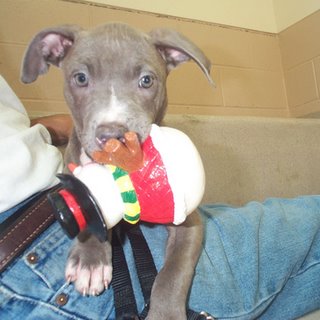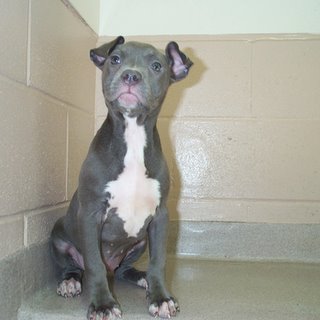Thursday, November 10, 2005
The Blues
Every dog we take into the SPCA is a risk. Temperament tests are not an exact science. They are a snapshot; a moment in time. Dogs who pass their primary and secondary evaluations are very likely to be of a stable, safe temperament. There are no guarantees.A few months ago, we took a very big risk and brought four blue pit bull puppies into the Oakland SPCA. Puppies are even harder to predict than adults because they're still in the process of becoming. Who a puppy is at ten weeks may not be who he is at twelve or sixteen weeks. The "switches" in the brain are being flicked on one by one, and as a puppy changes physically, behavior issues can develop. That makes any puppy a risk.
Pit bull puppies are even more likely to have issues because we know they are being carelessly and unintentionally bred in the Bay Area. Worse, some pit bulls are intentionally bred for temperaments that would make them unsuitable as safe companions. If you've read other blog posts, you already know that pit bulls are still flooding the shelters even as most other breeds' overpopulation is getting under control. They are a breed in crisis, and that unfortunately means that young, abandoned pit bull puppies are temperament wild cards.
Within the breed, the silvery-grey coat color known as "blue" has become highly desirable. The color blue is a somewhat uncommon one, and any time an uncommon color becomes popular, it means trouble for a dog breed. Because Dalmations MUST have that spotty coat, one out of every four are born deaf. The public's desire for blue merle Australian Shepherds resulted in careless breeding that created puppies often born both deaf and vision impaired. Harlequin Great Dane puppies often suffer the same fate, and don't even get me started on "white" Doberman Pinschers.
Science doesn't know exactly how coat color and these other genetic traits are linked, but breeding has shown us time and time again that it is connected. On a very basic level, the fewer variables you allow into a breeding program, the smaller the gene pool. The smaller the gene pool, the more problems you'll have. This is why every single pure breed has at least one health problem commonly affiliated with it. Now, take that already small gene pool, narrow it down to only a single color scheme and you haven't so much got a pool as you've got a puddle. Problems are inevitable. Responsible breeders of any breed will not risk the health of their lines just for the latest coat color fad, but those people breeding dogs for quick profit would rather sell the most popular aesthetic than bother with such trivial things as stable temperament and physical soundness.
The result for the pit bull population has been an explosion of beautiful silvery-grey pit bulls with fearful, panicky, quick-to-snap personalities. In a relatively nearby shelter, seven beautifully blue eight-week-old pit bull puppies were becoming available for adoption. The veterinarian working for the shelter was opposed to spaying or neutering earlier than six months, and so these highly desirable blue puppies of unknown temperament were going to be adopted out into the public unspeutered (spayed or neutered). Each puppy was going to go home with a spay/neuter waiver so the pup could be brought back and altered at six months. The adoption contract required the new owners to alter their dogs when they became six months old, but the truth was anyone could take one of these puppies home, choose not to fix him or her, and begin breeding.
The risk of taking these puppies into our shelter was nothing compared to the risk of putting them out into the public unaltered. We went down to get them they day they became available. By the time we arrived, three had already been adopted out. We gathered up the other four (all females) and headed back to the OSPCA.
Now the question became what to do with them. At eight weeks, all four puppies were behaving exactly as puppies should. They were interested in people, appropriately meek around older dogs, and curious but not frightened of the world around them. A great start, but only a start, and we had no way of predicting who they might become. On the other hand, we couldn't just stick them in a kennel and call them unavailable until they matured. It was time to try something new.
Each puppy became a special adoption. Those interested would fill out an application and allow a background check. We wouldn't adopt the puppies out to any first-time dog owners or to anyone under twenty-one. We wanted a home that had had experience with dogs and, ideally, experience with pit bulls. Each puppy would go into her potential home as a foster. Two series of classes, Puppy Preschool and Puppy Kindergarten, would be included in their foster period. This meant each puppy would be in a home for about three months without being officially adopted. During that time both the shelter and the potential adopters were allowed to call it quits at any time. We were looking to make sure the puppies continued to develop into normal, healthy, tempermentally-nice dogs. If they showed any signs of abnormal behavior, we would end the foster period and have the puppies returned to us. If at any point the foster felt they were unable to commit to the puppy in the way they'd originally intended, they were allowed to end the partnership as well. Our hope was that we'd minimize the risk and be more confident that all four were on their way to becoming well-behaved adult dogs. Graduation from Puppy Kindergarten class would also be official adoption day.
We named the four puppies Winifred, Edith, Gertrude, and Lillian. We spayed them and placed them up into adoptions. We assigned each puppy a trainer and taught interested volunteers how to help us socialize "the girls". And we waited.
None of us were surprised when the four pups sat in the kennels for a week. Then two. For many people looking for a puppy, pit bulls are already a hot-button topic. Now, we were asking for extra requirements to take one home? Why not just adopt a puppy of a different breed instead? But that was okay. We weren't looking to adopt the girls out to someone who wanted A puppy. We were waiting for the families who wanted THAT puppy.
Naturally, all four of the girls came down with kennel cough and spent some time in the back recovering. Volunteers were wonderful, doing everything from introducing the puppies to new toys to taking them on car rides. One by one, each puppy recovered and returned to adoptions. They each got a second DHPP vaccination and were allowed to play outside.

The first puppy to go home was Lillian. A young couple looking for an older pit bull instead fell for her hazel eyes and sensitive spirit. She was renamed "Winniford Pepperbottom" and after completing Puppy Preschool and Puppy Kindergarten, we hit a snag. Winnie began limping and the vets couldn't decide what was wrong with her. It's possible she may need surgery in the future, and even with this financial risk, she was offically adopted on graduation day of Puppy Kindergarten.

Several weeks later, it was Gertrude's turn. She went home with a family that had a toddler. Now renamed Deja, she solicits treats from her pint-sized playmate by sitting and staring adoringly into his eyes. She makes special effort to avoid jumping or jostling him and, even when running at full tilt, Deja will run around, rather than into, this youngest family member. She is pushy with other puppies, but plays better when allowed to carry a stuffed animal in her mouth. She was officially adopted only a few days ago.

The two remaining puppies were three and a half months old before Winifred was chosen. She too went home with a young child, and the family will be attending Puppy Kindergarten in the new year. So far, she is settling in well.

Edith went home only last week, although she had been on someone's mind for a while before that. A woman from Manteca had recently lost her fourteen-year-old pit bull to cancer. Enchanted by Edith's photo on the website Virtual Pet Adoptions, Edith served as her computer monitor's background for several weeks before the woman felt ready to drive to Oakland and meet her. Because Edith was now four and a half months old, and because this woman had come such a long way, we made an exception to the exception and allowed Edith to be officially adopted.
The story's not really over yet. It never is. But now, all four puppies have their tales continuing in new homes with new families. It was a long road to get there, but a road worth taking.











